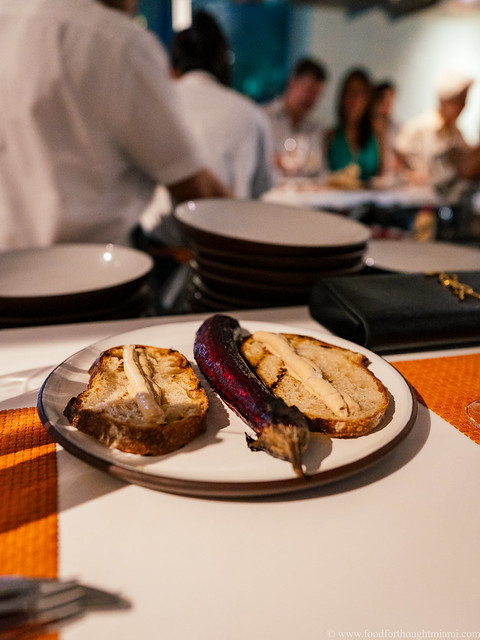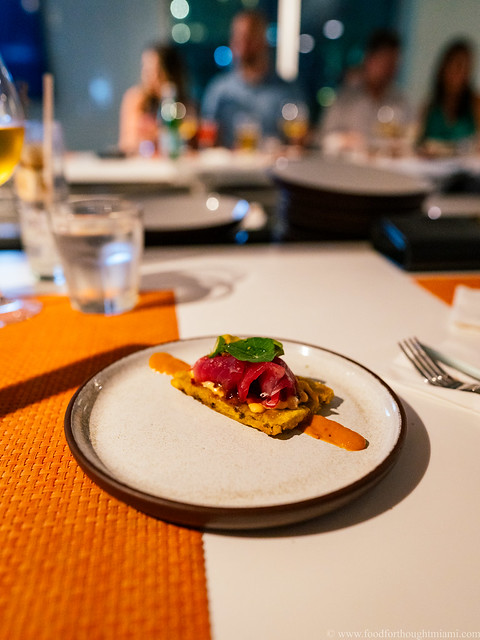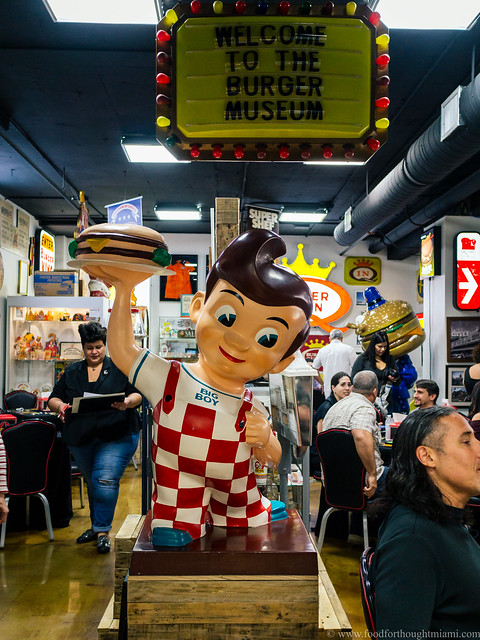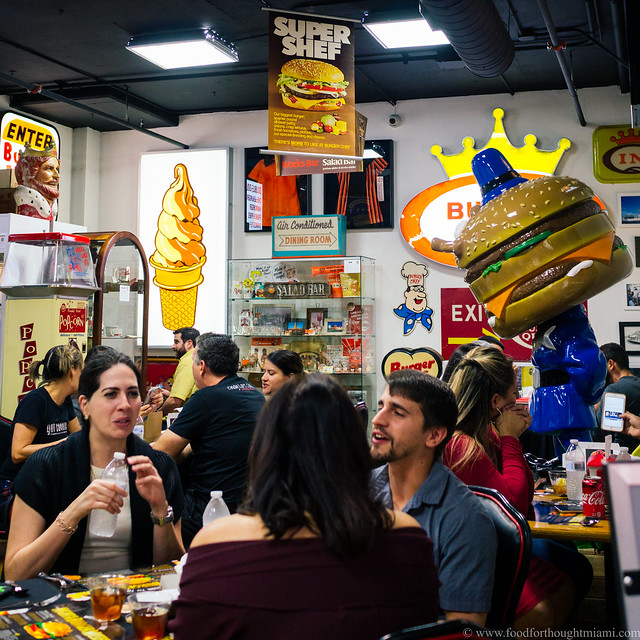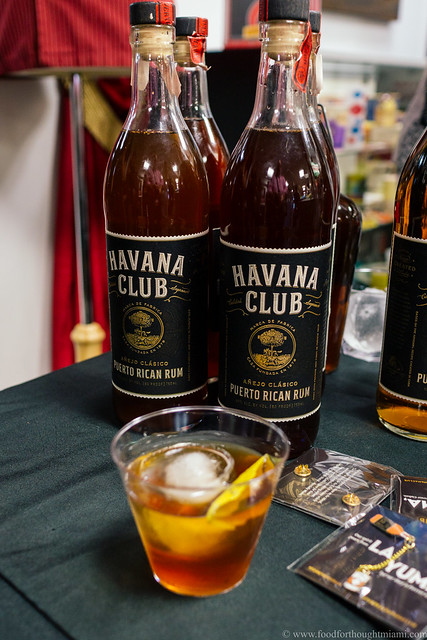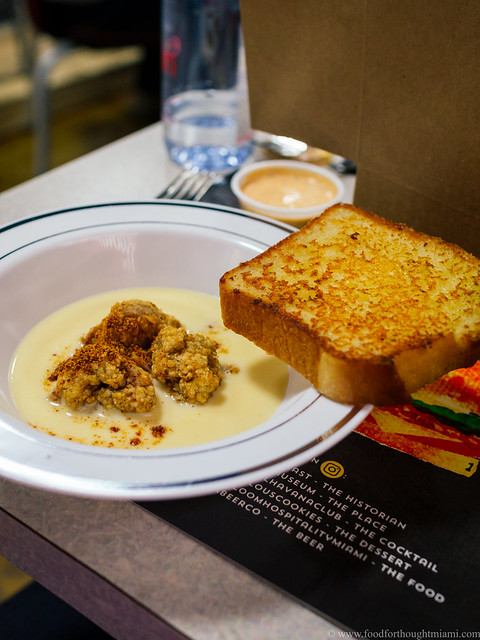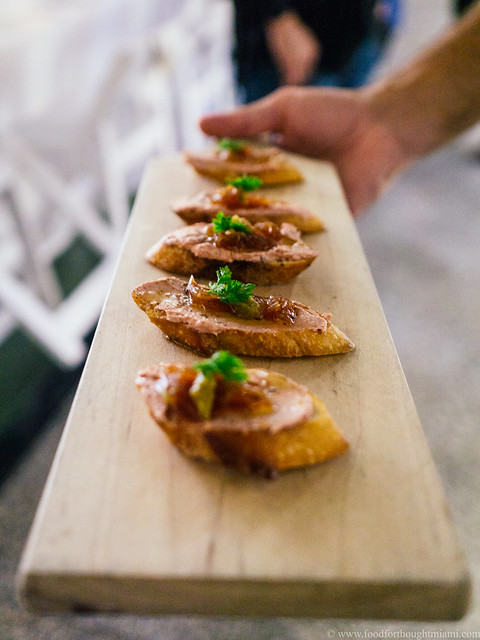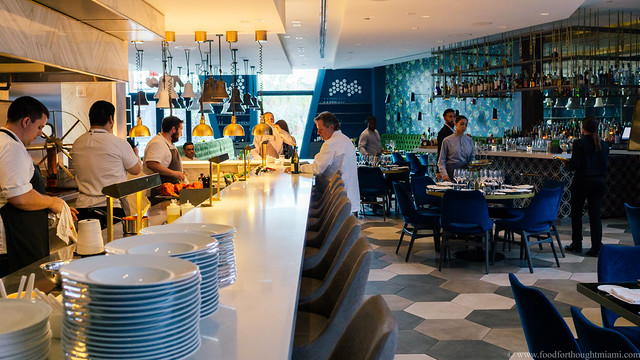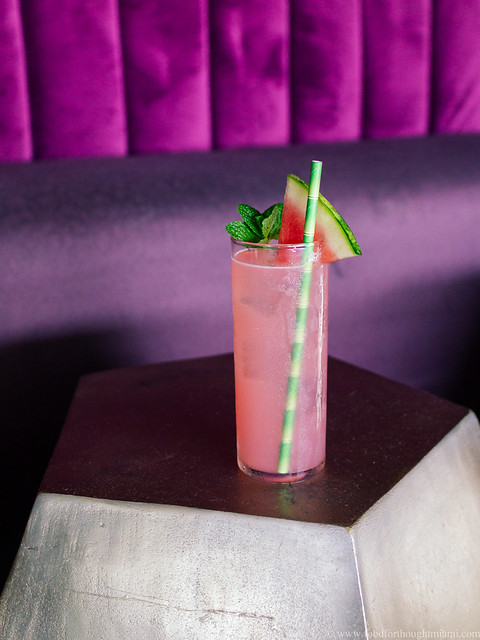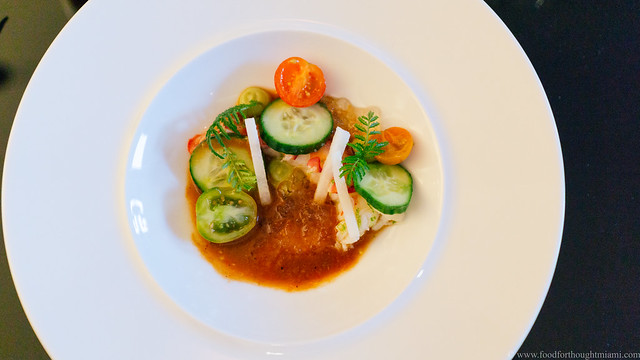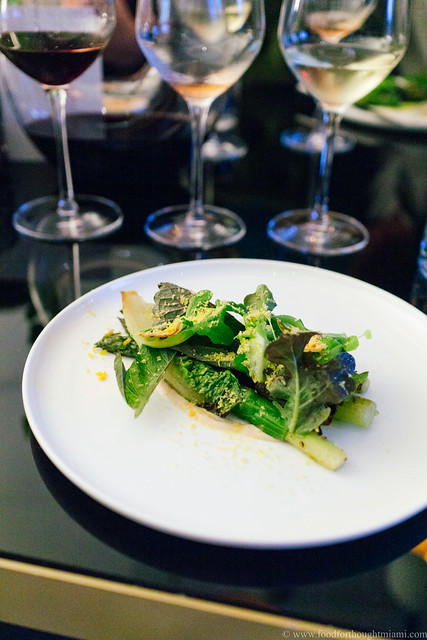Friday, August 23, 2019
Cobaya Isabela with Chef Jose Ramirez-Ruiz
Sometimes it takes an outsider to see the things you don't always see in yourself.
José Ramirez-Ruiz was a New Yorker through and through. He refined his cooking skills at some of the city's top restaurants – Per Se, Chef's Table at Brooklyn Fare, Isa – before going out on his own in 2012 with a pop-up in Williamsburg called "Chez José." Chez José eventually ripened into a full-blown restaurant called Semilla in late 2014. Despite its diminutive size – there was only seating for 18 around a U-shaped counter, and the staff consisted of a grand total of two cooks and two servers – Semilla earned accolades disproportionate to its stature. Pete Wells praised its vegetable-forward tasting menus in a two-star New York Times review in early 2015,[1] Eater's Ryan Sutton issued a glowing four-star review a couple months later, naming Semilla "New York's Next Great Restaurant,"[2] Eater's Bill Addison included it in his "21 Best New Restaurants in America," Bon Appetit included it in its top 10 "Best New Restaurants of 2015," and by that fall, Michelin awarded the restaurant a star.
But Semilla was not built to last – Ramirez-Ruiz's partner Pamela Yung, who handled Semilla's highly regarded breads and desserts, left late the following year, and by March of 2017 the restaurant was closed. In the aftermath, Ramirez-Ruiz found his way down to Miami on a corporate consulting gig. Fortunately for us, he's decided to stick around for a while, and recently has devoted himself full-time to opening a new restaurant – Isabela – in Little Haiti. Earlier this month, we got him to do a dinner with our Cobaya group that provided a preview of what's to come.
(You can see all my pictures from the dinner in this Cobaya Isabela with Chef Jose Ramirez-Ruiz flickr set).
Unlike many out-of-town chefs who have rolled into Miami like emperors visiting the backwards colonies, Ramirez-Ruiz arrived with humility and curiosity:
The result is a unique and fresh take on Miami's subtropical "local flora and fauna," as Ramirez-Ruiz puts it. He uses ingredients we're all familiar with – mangoes and papaya and plantains and yuca – but in new and inspired ways we haven't necessary seen before.
While he works on getting Isabela off the ground, a nearby space at Little River Miami played host for our dinner. I've now been here for a few different things – Eat Here Now's Friday lunches, Scott Linquist's Chivo! goat barbacoa – and while it's pretty bare-bones at the moment, the space also has some great potential. Lots of foliage from plant and floral designer Madre Selva, which keeps a studio nearby, helped soften the rough edges.
Ramirez-Ruiz started things off with a round of snacks, all brought out to the tables at once: delicate little mussels swimming in paprika-laced oil with sautéed onions, in the style of the wonderful canned seafood conservas of Spain and Portugal; flat-out delicious green olives stuffed with shrimp paste and warmed in the wood oven; rounds of fresh cheese also roasted in the oven and doused in a lemon vinaigrette, a sort of saganaki minus the flaming tableside presentation; some Wigwam country ham from Edwards Smokehouse;[3] and freshly baked sourdough bread, served with an army-green moringa butter. I've been told that moringa doesn't have a lot of flavor on its own, so maybe there was something else in here, but it had an intriguing, vegetal thing going on that I kept on coming back to for more.
I'd been to Ramirez-Ruiz's pop-up dinners at All Day and Jaguar Sun, and each time he'd served some variation on this dish: a creamy plantain soup, with melting comté cheese and crispy plantain "crunchies." It eats like a crazy hybrid of a Caribbean sopa de platano and a French onion soup, and this was possibly my favorite iteration.
(continued ...)
Sunday, August 4, 2019
a decade of cobaya
It was exactly ten years ago to the day that Steven (a/k/a Chowfather), Steve (a/k/a Blind
Mind) and I hosted our first Cobaya "underground" dinner. Those were interesting times. Following the financial crisis of 2007-08, the food world seemed to be at something of an inflection point. Chefs like David Chang were pulling the chair out from the pretensions of fine dining and replacing it with a hard, backless stool in front of the kitchen counter at Momofuku Ko. Food trucks were a big thing, where aspiring restaurateurs could pursue their dreams without the big capital outlay required for a brick-and-mortar build-out. The hegemony that newspapers exercised over public discourse on restaurants was being undermined from one side by Yelp, and from the other by these things called "blogs" where anyone with some rudimentary knowledge of how to operate a computer could publish their thoughts to the internet. Many would do so with actual thoughtfulness and insight, and often with a side of snark.[1] Instagram didn't even exist yet.
Locally, Michelle Bernstein and Michael Schwartz were the queen and king, respectively, of Miami dining, with bookend Beard Awards to prove it (Michelle won Best Chef: South in 2008, Michael won the same award in 2010).[2] Since then, Michael's opened more restaurants than I can count,[3] while Michelle took a different direction; she recently opened Cafe La Trova on Calle Ocho with cantinero and longtime compadre Julio Cabrera (recently named Tales of the Cocktail's Bartender of the Year), and continues to run a high-end catering operation, but these days you're equally likely to see her on T.V., hosting "Check, Please!" or "SoFlo Taste," as in a restaurant kitchen. Good for her; it's a crazy life. Meanwhile, back in 2009, many of those who are now among Miami dining's most prominent names were still sharpening their knives: to name just a few, Brad Kilgore was working his way through some of Chicago's top kitchens, Zak Stern (a/k/a Zak the Baker) was traipsing around Europe, making cheese, herding goats, and occasionally baking bread at my kids' summer camp, Jose Mendin was still a year away from opening the original PubBelly.
It was a long time ago – longer than the lifespan of most restaurants.
I've told the Cobaya origin story many times when folks ask, "How did you start doing this?", but never written it down. Many of you have probably heard it before. The whole thing started in the valet circle of a Sunny Isles hotel. A couple chefs, Kurtis Jantz and Chad Galiano, had cobbled together a group of "food-focused locals" to be their focus group for a new restaurant concept. They'd found most of us online, probably primarily via Chowhound, which back in the day actually hosted a somewhat lively food discussion on its boards. That was how most of us knew each other as well, though a few of us had met in person. As the Steves and I were waiting for our cars at the end of the evening, we started talking about the then-current trend of "underground dining" groups.
Two questions triggered it: "Why not here?" And then: "Why not us?" And just like that, we decided to do it ourselves. We posted something on a Google message board that I'd used to organize a few other get-togethers,[4] started a website, and posted a mission statement:
The goal here is a very simple one - to get talented chefs to cook great, interesting, creative meals for an audience of adventurous, open-minded diners. That may happen inside a restaurant, it may happen outside of one. It may be a multi-course tasting menu, it may be a family-style whole hog dinner (here's hoping). For those who question the "underground" street cred of this mission, those questions are perfectly legitimate. My answer is, "I don't care." We're not limiting ourselves to meals cooked in abandoned warehouses in secret locations disclosed the day before the dinner; we're also not limiting ourselves to white tablecloths and silverware changed between every course. We're very open-minded that way: all that matters is if the food is good, and we think there's enough similar-minded folks to make that game plan sustainable.
Every invitation comes with a disclaimer: there is no "menu". There are no choices. You'll be eating what the chef chooses to make for the night. If you have food related allergies, strict dietary requirements, religious restrictions; are salt sensitive, vegetarian, pescatarian, or vegan; don't like your meat cooked medium rare, or are pregnant: this meal is probably not for you. Do not expect white-glove service. Don't ask for your sauce on the side. Just come and enjoy.[5]Truth is, we hadn't quite honed our modus operandi yet – we let everyone know the restaurant that it was going to be at, and a preview menu got posted a couple days in advance – but the basic idea was that the chefs were going to get to cook whatever they wanted and the folks who showed up would get to eat it. We had no idea what kind of reaction it would get, but we wound up with a group of sixteen who wanted in.
On August 4, 2009, we hosted our first "Cobaya" dinner at Talula. Andrea Curto-Randazzo was the chef, along with her then sous chef, Kyle Foster.[6] It is still one of my favorite Cobaya meals, and I still pine for that tripe risotto.
What we found out is that there was actually tremendous demand in Miami for this kind of thing. We announced our next event a couple months later, and got so many responses that we added a second seating for the following night. Chef Jeremiah Bullfrog wound up doing two rounds of seven courses for 36 diners in a penthouse suite in Midtown Miami. I brought Frod Jr., who was 12 years old at the time, along to one of those, and he still remembers Jeremiah offering him a cigar and a beer as we hung out on the balcony post-service.[7]
Since then, we've put on a total of 77 of these "experiments." We've worked with some of Miami's most highly regarded chefs,[8] an even greater number of skilled and creative but less-celebrated talents, and the occasional visitor from places further afield.[9] We've had Andrew Zimmern join us for a dinner, which wound up being featured on his show "Bizarre Foods America,"[10] and then later cook for us at a couple events we co-hosted with the South Beach Wine and Food Festival. We've eaten with our hands at "kamayan" Filipino feasts in fancy South Beach restaurants, and we've eaten at a backyard farm in Homestead.
We've been served pig's heads, lamb's heads, goat's heads, pig's brains, veal brains, pig skin noodles, lamb's livers, rabbit's livers, beef tendon chicharrones, sweetbreads, duck testicles, mushroom dinuguan, morcilla toast, beef heart tartare, grasshoppers, silkworms, waterbugs, ant eggs, abalone, geoduck, turtle, blowfish, suckling pigs and smoking cows and kangaroo and rabbit and venison and goat, not nearly enough tripe, and enough foie gras to stuff a flock of geese. We haven't actually had guinea pig yet, unless you want to count a guinea hen stuffed with pig (a noble effort). We've had a dinner with truffles for every course, and another where we drank liquors from the 1950's-1970's with every course, and another – Cobayapalooza! – with seven different chefs for each course.
We've had roughly a thousand different people attend our experiments, and now routinely have to deal with the fortunate but nonetheless demanding challenge of receiving 250-350 requests for the 25-35 spots we typically have available for each of these events. We've spent a lot of time and effort trying to find ways to handle those requests fairly and in a way that maximizes the most people's opportunity to join us, while also making sure we can timely fill the spots that we have.[11]
Through it all, we've remained faithful to that mission statement, encapsulated in that first sentence: "The goal here is a very simple one - to get talented chefs to cook great, interesting, creative meals for an audience of adventurous, open-minded diners." I feel very fortunate to have been able to do exactly that for the past ten years, and to meet and eat with so many wonderful people along the way. Thanks for your support.
[1] R.I.P. "Eat Me Daily."
[2] No South Florida chef has won the award since 2010, though I think Miami can still claim as one of its own the wonderful Nina Compton, 2018's winner for her New Orleans restaurant Compere Lapin.
[3] Let me try from memory, without cheating: Michael's Genuine, Harry's Pizza, Ella, Genuine Pizzas in Coconut Grove, Atlanta, and Cleveland (?), Amara at Paraiso, Tigertail & Mary, and Traymore at the Como. (edited to add: I was close. The Atlanta Genuine Pizza closed but there's the original Harry's in the Design District plus Coconut Grove, Aventura, and Dadeland; and it's a Michael's Genuine that recently opened in Cleveland, not a Genuine Pizza. And while I thought Schwartz was no longer affiliated with Fi'lia because of a split with SBE, it's still included on the Genuine Kitchen website?). (edited again to add: so literally a day after I posted this, Schwartz announced he's closing the Dadeland Harry's. I guess I wasn't the only one not paying attention.)
[4] Again reflecting the centrality of Chowhound back then, we called these events "chowdowns," as they did on the other Chowhound regional boards, and I wound up with the idiotic "miamichowdown" email address that I still use for food-related things.
[5] Some of this was unapologetically stolen from an event announcement from Chef Jeremiah Bullfrog, who should probably see if he knows any lawyers he can talk to.
[6] Talula closed the following year, and it is still one of my all-time favorite Miami restaurants. Andrea continues to run Creative Tastes Catering with her chef husband Frank Randazzo. Kyle moved to Denver, where he's chef-owner of Julep. Kyle made some of the best offal dishes I've ever had, and I'm glad he's continuing that work at the Southern-inspired Julep, where the menu includes scrapple fries, chicken tail skewers, and rocky mountain oysters rockefeller. Another name you might recognize from the Talula kitchen: the outstanding pastry chef Antonio Bachour, though I think by the time of our dinner there he'd already moved across the street to work at the W South Beach.
[7] Another great connection from that dinner: the owner of the Midtown Miami condo that hosted our dinner ran a digital design company. One of their web developers was at the event and struck up a friendship with Jeremiah, then began working for him on the side, and ultimately wound up devoting himself full-time to the food business. Steve Santana – a/k/a @SliceDiceCode – now runs Taquiza, making the best tortillas in Miami, with locations in South Beach, North Beach and at The Citadel. I'd like to think that Cobaya can claim at least a small measure of responsibility for advancing Miami's taco game.
[8] A special acknowledgment here needs to go to Michelle Bernstein, who agreed to do a dinner with us back in 2011, when we'd been at it less than two years and hosted less than a dozen of these things.
[9] Sometimes when I look back at the list of experiments, I'm still flabbergasted by the names I see there: Bernstein, Schwartz, Norman Van Aken (a longtime culinary idol of mine), Nina Compton, Andrew Carmellini, Francis Mallmann, Carlo Mirarchi, Jon Shook and Vinny Dotolo, Jeremiah Stone and Fabian Von Hauske, Justin Smillie, Katsuya Fukushima, Alex Talbot. What a thrill it's been to be able to approach these people and just say: "Cook for us."
[10] Zimmern gave a nickname to the sous chef working that dinner at Azul: "Wall Street," for his hair, which he wore slicked back, Gordon Gekko style. "Wall Street" no longer wears his hair slicked back, but found his way to success: Brad Kilgore now heads up Alter, Brava, Kaido and Ember.
[11] It continues to be a perennial problem that people ask for spots and then don't book them, so that we're always left to back-fill from the wait-list. When I hear restaurateurs complain about reservation no-shows, I listen with complete empathy.
[2] No South Florida chef has won the award since 2010, though I think Miami can still claim as one of its own the wonderful Nina Compton, 2018's winner for her New Orleans restaurant Compere Lapin.
[3] Let me try from memory, without cheating: Michael's Genuine, Harry's Pizza, Ella, Genuine Pizzas in Coconut Grove, Atlanta, and Cleveland (?), Amara at Paraiso, Tigertail & Mary, and Traymore at the Como. (edited to add: I was close. The Atlanta Genuine Pizza closed but there's the original Harry's in the Design District plus Coconut Grove, Aventura, and Dadeland; and it's a Michael's Genuine that recently opened in Cleveland, not a Genuine Pizza. And while I thought Schwartz was no longer affiliated with Fi'lia because of a split with SBE, it's still included on the Genuine Kitchen website?). (edited again to add: so literally a day after I posted this, Schwartz announced he's closing the Dadeland Harry's. I guess I wasn't the only one not paying attention.)
[4] Again reflecting the centrality of Chowhound back then, we called these events "chowdowns," as they did on the other Chowhound regional boards, and I wound up with the idiotic "miamichowdown" email address that I still use for food-related things.
[5] Some of this was unapologetically stolen from an event announcement from Chef Jeremiah Bullfrog, who should probably see if he knows any lawyers he can talk to.
[6] Talula closed the following year, and it is still one of my all-time favorite Miami restaurants. Andrea continues to run Creative Tastes Catering with her chef husband Frank Randazzo. Kyle moved to Denver, where he's chef-owner of Julep. Kyle made some of the best offal dishes I've ever had, and I'm glad he's continuing that work at the Southern-inspired Julep, where the menu includes scrapple fries, chicken tail skewers, and rocky mountain oysters rockefeller. Another name you might recognize from the Talula kitchen: the outstanding pastry chef Antonio Bachour, though I think by the time of our dinner there he'd already moved across the street to work at the W South Beach.
[7] Another great connection from that dinner: the owner of the Midtown Miami condo that hosted our dinner ran a digital design company. One of their web developers was at the event and struck up a friendship with Jeremiah, then began working for him on the side, and ultimately wound up devoting himself full-time to the food business. Steve Santana – a/k/a @SliceDiceCode – now runs Taquiza, making the best tortillas in Miami, with locations in South Beach, North Beach and at The Citadel. I'd like to think that Cobaya can claim at least a small measure of responsibility for advancing Miami's taco game.
[8] A special acknowledgment here needs to go to Michelle Bernstein, who agreed to do a dinner with us back in 2011, when we'd been at it less than two years and hosted less than a dozen of these things.
[9] Sometimes when I look back at the list of experiments, I'm still flabbergasted by the names I see there: Bernstein, Schwartz, Norman Van Aken (a longtime culinary idol of mine), Nina Compton, Andrew Carmellini, Francis Mallmann, Carlo Mirarchi, Jon Shook and Vinny Dotolo, Jeremiah Stone and Fabian Von Hauske, Justin Smillie, Katsuya Fukushima, Alex Talbot. What a thrill it's been to be able to approach these people and just say: "Cook for us."
[10] Zimmern gave a nickname to the sous chef working that dinner at Azul: "Wall Street," for his hair, which he wore slicked back, Gordon Gekko style. "Wall Street" no longer wears his hair slicked back, but found his way to success: Brad Kilgore now heads up Alter, Brava, Kaido and Ember.
[11] It continues to be a perennial problem that people ask for spots and then don't book them, so that we're always left to back-fill from the wait-list. When I hear restaurateurs complain about reservation no-shows, I listen with complete empathy.
Saturday, July 20, 2019
Cobaya Obra with Chef Carlos Garcia
For years, Chef Carlos Garcia ran what was generally regarded as one of the top dining destinations in Latin America in his hometown of Caracas, Venezuela. Between 2013-2016, his restaurant Alto was a regular on the Pellegrino "Latin America's 50 Best Restaurants" list. But Venezuela, wracked by political and economic strife, has been a challenging place to live, much less run a restaurant. Like many others fortunate enough to have the opportunity, Garcia found a second home here in Miami, opening a restaurant in Brickell, Obra Kitchen Table, last year.
Despite everything happening at home, Garcia has managed to keep Alto open while running Obra here – no easy feat amidst protests, government clampdowns, and food shortages. He also helps operate Barriga Llena Corazón Contento (Full Belly Happy Heart), an organization that supplies free meals to children in Venezuela, and Recipes for Change, which teams up local chefs, farmers and others to serve people in need here in South Florida. Somewhere in there, he found time to put on a dinner for Cobaya, gathering thirty diners around the counter at Obra for a seven-course dinner.[1]
(You can see all my pictures in this Cobaya Obra with Chef Carlos Garcia flickr set).
I really love the layout at Obra, where there's a smattering of tables in front, but the bulk of the seating is at a long, three-sided counter that surrounds the open kitchen, a variation on the sort of horseshoe type counter you would find in old diners like S&S.
Chef Garcia started the meal with some snacks: a puffy arepita topped with sea urchin and guasacaca sauce (a Venezuelan staple that I think of as either a salsa verde bolstered with avocado, or a very loose guacamole), and some feathery, crisp chicharrones for scooping up a cauliflower cream enriched with a generous dollop of trout roe. A great start.
To follow, a whole Japanese eggplant (here's where you can make an entirely appropriate use of the 🍆 emoji), basted in beet juice and red wine before being roasted until it's all supple and silky inside. The menu listed this as "eggplant + goat cheese + red wine," but those toasts were instead topped with foie gras butter – a substitution I fully support. While foie often gets matched up with sweet, fruity flavors, I really enjoy when it gets to play with more savory, vegetal elements.
Chef Garcia called his tostone a "toast/ton," which he then topped with ribbons of fresh raw tuna, avocado, jalapeño, and a spicy guava sauce.
(continued ...)
Friday, July 5, 2019
Cobaya Kamayan at Pao
We've been on a bit of a hiatus at Cobaya for a while, but returned to action last month with a return visit to Pao at the Faena Hotel. Pao had been the site of Experiment #63 a few years ago, when chef Paul Qui and his then chef de cuisine Derek Salkin put together an eight-course menu that had the look and feel of a "fine dining" meal, but which resonated with Filipino flavors: kumamoto oyster kinilaw, foie gras lumpia, maitake mushroom dinuguan, oxtail and beef tongue kare kare.
This time around, Paul and CDC Ben Murray – who joined Pao a few months after that last dinner and has been heading up the Miami restaurant for the past 2 1/2 years – took us even deeper into Filipino territory with a kamayan dinner.[1]
As our guinea pigs arrived, they were brought onto the back terrace at Pao, where one long table underneath a thatched roof pergola had been draped with banana leaves and then laden with our dinner for the evening.
(You can see all my pictures in this Cobaya Kamayan at Pao flickr set).
They described it on the menu like so:
It was a lot to take in at once. There was sticky, crispy edged lechon, slices of rich wagyu beef, sticky sweet ribs, fat, well-spiced grilled shrimp, tender chicken inasal (typically marinated in calamansi juice and coconut vinegar), flaky grilled loup de mer. There was achara (the Filipino version of papaya salad), kimchi, grilled bok choy, planks of pickled daikon radish. There were crisp fried plantain chips, batons of juicy grilled pineapple, mangoes halved and cross-hatched. There were puffy little pan de sal buns, and more rice than forty people could possibly consume in one sitting. There were sauces – a spicy-sweet nam jim, a salty-tangy toyomansi, a bright garlic and black pepper vinegar.
Instead of an impeccably plated, rigorously calibrated multi-course tasting menu, this was a free-for-all: take a little bit of this, then maybe some of that, try it with this sauce and then the next bite with another. Paul said that Flipinos like eating savory and sweet together, and while that's usually not my thing, in this context it made complete sense.
(continued ...)
This time around, Paul and CDC Ben Murray – who joined Pao a few months after that last dinner and has been heading up the Miami restaurant for the past 2 1/2 years – took us even deeper into Filipino territory with a kamayan dinner.[1]
As our guinea pigs arrived, they were brought onto the back terrace at Pao, where one long table underneath a thatched roof pergola had been draped with banana leaves and then laden with our dinner for the evening.
(You can see all my pictures in this Cobaya Kamayan at Pao flickr set).
They described it on the menu like so:
"A Kamayan Dinner is a communal style Filipino feast, composed of colorful arrays of food that are usually served on banana leaves and eaten without utensils."
It was a lot to take in at once. There was sticky, crispy edged lechon, slices of rich wagyu beef, sticky sweet ribs, fat, well-spiced grilled shrimp, tender chicken inasal (typically marinated in calamansi juice and coconut vinegar), flaky grilled loup de mer. There was achara (the Filipino version of papaya salad), kimchi, grilled bok choy, planks of pickled daikon radish. There were crisp fried plantain chips, batons of juicy grilled pineapple, mangoes halved and cross-hatched. There were puffy little pan de sal buns, and more rice than forty people could possibly consume in one sitting. There were sauces – a spicy-sweet nam jim, a salty-tangy toyomansi, a bright garlic and black pepper vinegar.
Instead of an impeccably plated, rigorously calibrated multi-course tasting menu, this was a free-for-all: take a little bit of this, then maybe some of that, try it with this sauce and then the next bite with another. Paul said that Flipinos like eating savory and sweet together, and while that's usually not my thing, in this context it made complete sense.
(continued ...)
Monday, January 21, 2019
best dishes of 2018 - part 3
 |
| herbed tostada - Willows Inn |
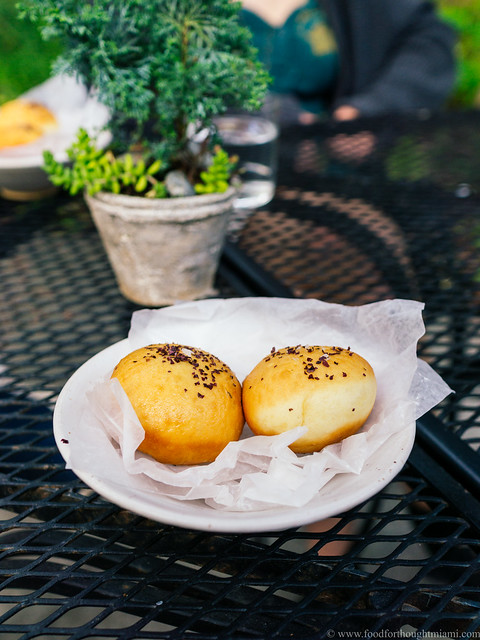 |
| smoked black cod doughnuts - Willows Inn |
 |
| smoked sockeye salmon - Willows Inn |
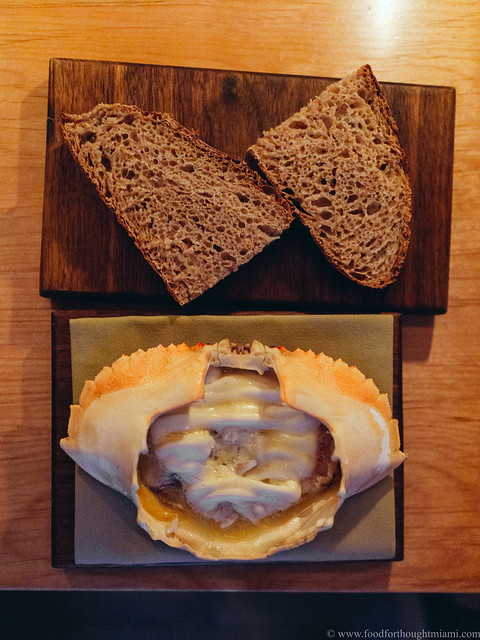 |
| heirloom wheat bread, crab brain - Willows Inn |
 |
| fruits and their leaves and kernels - Willows Inn |
It's unusual for a restaurant to have multiple "signature" dishes, but several from Willows Inn could easily be called that: the "tostada" crafted from a tempura-fried mustard leaf, smeared with an oyster and herb emulsion and festooned with everything fresh and blooming from the garden, a different burst of flavor in every bite; the puffy donuts stuffed with smoked black cod, sprinkled with sea salt and dried seaweed; the perfect smoked salmon, about which I said five years ago: "You realize: this is the best salmon you are ever going to eat in your life." I didn't consider at the time: you can always go back. This time was just maybe even better.
The other dishes pictured here reflect how Wetzel so effectively captures place and time, location and season. During our first two visits, a hearty bread course was one of the highlights, in large part because it came with a ramekin of rich, sticky chicken drippings for dipping. This time, instead of chicken drippings, there was a crab carapace – from nearby waters, of course[1] – filled with bits of warm crabmeat covered in a thick blanket of creamy crab brains, with an intense but clean and pure taste of the sea. Frod Jr. told me months later he was still thinking about how good this was. Yup. Dessert was pretty magical too: an assortment of fruits captured at their peak of ripeness, paired up with something else from the same fruit: peaches and blackberries with ices made from their leaves, plums in a syrup of their kernels, obscenely fresh figs right off the tree with a fig leaf cream.
When I win the lottery – or maybe even if I don't – this is where you'll find me one day.
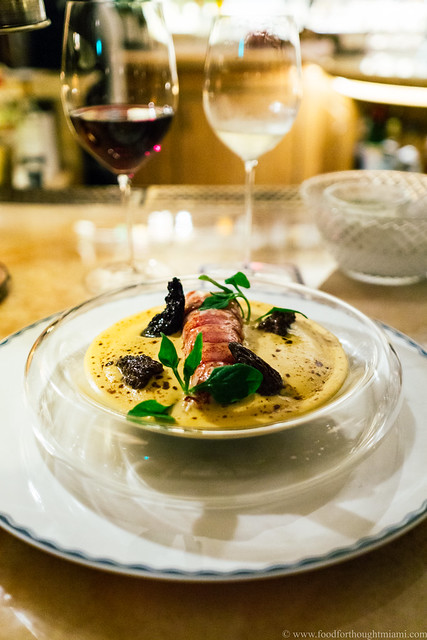 |
| lobster thermidor - The Surf Club Restaurant |
The space is gorgeous, the service is outstanding, the execution is precise, but the choices are just ... so ... dull. I get the whole “throwback” theme, and it provides some highlights (the Oysters Rockefeller are second only to Galatoire’s IMO, and I thought the Lobster Thermidor was great), and I like going there. But when I heard we were getting a Thomas Keller restaurant, and when he brought in a creative, talented chef like Manuel Echeverri, who was doing great things at Bazaar Mar, to run the kitchen – well, I was hoping for something more.
The truth is, I have ambivalent feelings about the Surf Club. I've thoroughly enjoyed my three visits there; just not so much for the food, which has been good, but not particularly memorable. I expected more things like the Lobster Thermidor, an Escoffier classic which frankly I'd never had a particularly good example of until this one. Instead of the typical stodgy spackle mounded into a lobster shell, this version held some surprises: a ragout of lobster meat and vegetables plus a thin sheet of crispy puff pastry concealed under a burnished blanket of cream and cheese, the perfume of tarragon wafting from within, all serving as the bed for a precisely cooked lobster tail, some preserved morels providing a rich, woodsy counterpoint which acted as a bridge for the aromatic red Burg that wine director Zach Gossard generously poured for me. More like this, please.
(continued ...)
Monday, December 31, 2018
best dishes of 2018: part 2
Though I'm not posting as frequently of late, I did at least manage to start my "best of 2018" list before 2019 actually started, which is better than I did last year (though I may not finish before the year comes to a close). You can read Part 1 here, where we left off in Los Angeles. We'll pick up here back in Miami before bouncing around some more, to the Hudson Valley, the Bay Area, Chicago, British Columbia, and Greece. As always, despite the title playing to the traditional year-end trope, there's no pretense here that this list represents the "best" of anything other than a compendium of personal favorites from the past year of dining, listed in roughly chronological order.
2018 was the year the omakase sushi trend came to town. Though Naoe will celebrate a ten year anniversary in a few months, and there have always been a couple other places that will do an omakase if you know how to ask, until this past year Miami had no other dedicated omakase venues. That's changed with the addition of The Den at Azabu, from a group which opened first in Tokyo and then NYC before bringing their talents to South Beach, and Hiden (which is still on my to-do list, and booked for next month).
The Den is a private room at Azabu dedicated to omakase sushi service, seating about twelve total. With the minimalist aesthetic, pale wood surfaces, and dining counter surrounding the sushi chefs, it feels very much like the places we visited in Japan. And with a base price starting at $120 for about fourteen courses, it's a relative value. The fish and rice were all of good quality, but the standout item for me was one of the opening dishes which served as precursor to the sushi: tarabagani (king crab), grilled, the meat picked from the shell and served warm in a stone bowl, draped with a blanket of kani miso – crab "miso," which is a nice way of saying the crab's rich, creamy, deeply flavored guts.
More college tours with Little Miss F took us close enough to the Hudson Valley to justify a trip to a place I've long wanted to try: Zak Pelaccio's Fish & Game. I loved absolutely everything about it – the old brick building, the cozy dining room and bar/lounge area with fireplaces ablaze, Zak and his dog bounding through the restaurant toward the end of lunch service. All of the food was just delicious, including a crab omelet with chili crab sauce that hearkens back to Zak's Fatty Crab days. But my favorite was a dish of creamy, meaty beans cooked in the hearth, along with some plump little clams, bits of grilled squid, wispy bok choy leaves, and a hit of sambal. A wonderful dish and a wonderful place.
Back home in Miami, it was time for Duck Duck Goose, Chef Jeremiah Bullfrog's avian spin-off from P.I.G. (Pork Is Good), hosted at The Anderson. Jeremiah throws the best food parties in town, and D.D.G. was no exception. Some of South Florida's best chefs served some great dishes – gorgeous duck confit terrines with mushroom gelée from David Coupe and Josue Peña of Faena, Jeremiah's crispy tripe and duck wings with Szechuan chili oil, Itamae's arroz con pato maki, Babe Froman's duck sandwich in the style of a Philly / Italian roast pork sandwich were all standouts. But the best dish of the day – and one of my favorites of the year – came from an out-of-towner, Washington D.C.'s Katsuya Fukushima of Daikaya (and also a Cobaya alumnus, from Experiment #10 way back in 2010). He did these onigiri, stuffed with slow-cooked, miso-seasoned duck, then topped with a torched duck fat miso sauce. Obscenely rich in the best possible way.
June found us in the Bay Area for a visit with Frod Jr., where we paid homage to an institution: Chez Panisse. It had been two, possibly three, decades since I'd been. And guess what? It's still genuinely great.
If I told you that a rustic-looking place, with a charcoal grill and wood burning oven, serving food straight from the farms, fields and docks had just opened in the East Bay, you'd probably think it was right on trend. It's a testament to the restaurant's outsize influence; and, I suppose some would say, to the stagnancy of what's come to be known as "California Cuisine." There's a reason for the genre's staying power, though: when it's done right, it's still very good, especially in Northern California, which produces some of the greatest raw ingredients on the planet. And Chez Panisse is still doing it right.
Throughout dinner, I watched somewhat nervously as a galette out on that kitchen counter was gradually whittled down to only a couple slices. Fortunately there was still one remaining when we ordered dessert. A burnished, flaky crust was the vehicle for juicy, fragrant, bright-flavored apricots, paired simply with a scoop of vanilla ice cream. It was perfect. There seems to be a backlash these days against "name-checking" on menus; me, I'm happy to know that if I ever see Golden Sweet apricots from Blossom Bluff Orchards, I should buy as many as I can lay my hands on.
Speaking of "California Cuisine" – Justin Smillie's Upland already made an appearance in Part 1 of this list for a dish he served at our Cobaya dinner. I was back again for more later – more and more frequently. There are several fixtures on the menu there that I crave regularly – the gem lettuce salad topped with ribbons of ricotta salata, the crispy duck wings with yuzu kosho, the wood-fired prawns, the bucatini cacio e pepe – but maybe the best thing I had was a wonderful dish that combined smoked duck breast, still shaded a rosy pink, with green plums, shaved fennel, green almonds, a sort of pesto sauce, and a generous pile of greens and herbs. This is what Smillie does so well at Upland, these dishes that taste like a garden but are still hearty, that look and eat so casual but are executed with refinement and touch.
(continued ...)
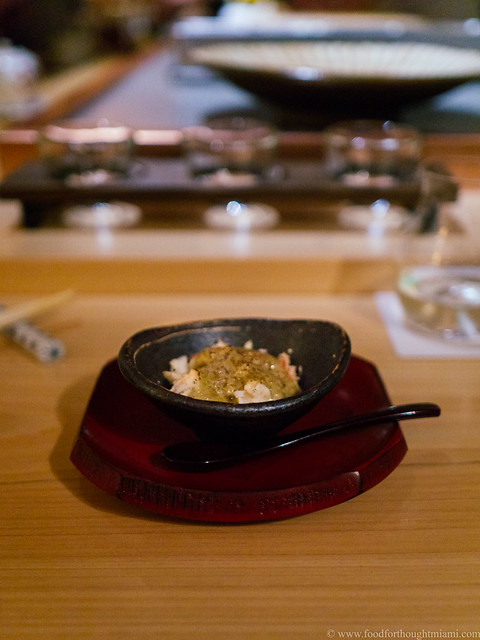 |
| tarabagani kani miso yaki - Den at Azabu |
The Den is a private room at Azabu dedicated to omakase sushi service, seating about twelve total. With the minimalist aesthetic, pale wood surfaces, and dining counter surrounding the sushi chefs, it feels very much like the places we visited in Japan. And with a base price starting at $120 for about fourteen courses, it's a relative value. The fish and rice were all of good quality, but the standout item for me was one of the opening dishes which served as precursor to the sushi: tarabagani (king crab), grilled, the meat picked from the shell and served warm in a stone bowl, draped with a blanket of kani miso – crab "miso," which is a nice way of saying the crab's rich, creamy, deeply flavored guts.
 |
| hearth cooked beans, clams, grilled squid, sambal, bok choy - Fish & Game |
 |
| aburi miso onigiri with miso seasoned slow cooked kamo - Katsuya Fukushima |
 |
| Blossom Bluff Goldensweet apricot galette - Chez Panisse Café |
If I told you that a rustic-looking place, with a charcoal grill and wood burning oven, serving food straight from the farms, fields and docks had just opened in the East Bay, you'd probably think it was right on trend. It's a testament to the restaurant's outsize influence; and, I suppose some would say, to the stagnancy of what's come to be known as "California Cuisine." There's a reason for the genre's staying power, though: when it's done right, it's still very good, especially in Northern California, which produces some of the greatest raw ingredients on the planet. And Chez Panisse is still doing it right.
Throughout dinner, I watched somewhat nervously as a galette out on that kitchen counter was gradually whittled down to only a couple slices. Fortunately there was still one remaining when we ordered dessert. A burnished, flaky crust was the vehicle for juicy, fragrant, bright-flavored apricots, paired simply with a scoop of vanilla ice cream. It was perfect. There seems to be a backlash these days against "name-checking" on menus; me, I'm happy to know that if I ever see Golden Sweet apricots from Blossom Bluff Orchards, I should buy as many as I can lay my hands on.
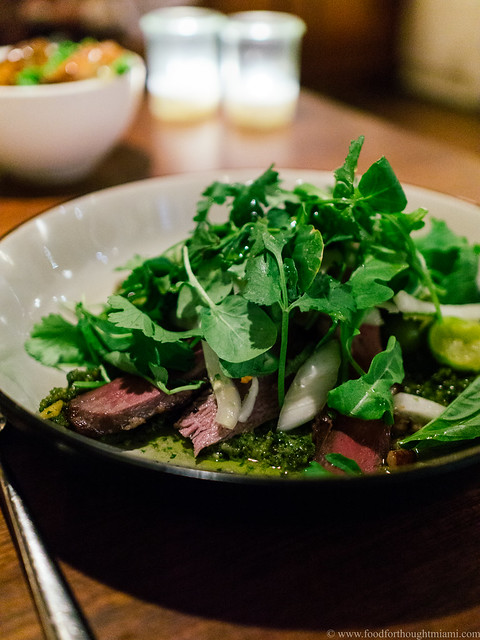 |
| smoked duck magret, green plum, fennel + green almonds - Upland |
(continued ...)
Saturday, December 29, 2018
best dishes of 2018: part 1
This time last year, I felt out of touch with much of the local dining universe: 2017 was the year of the "to-do list" for me, during which the much-talked-about local openings outpaced even my appetite (or at least my schedule). But 2018 was the year of catching up, at least to some extent. After submitting my list of "Top Restaurant Newcomers" for Eater's annual year in review, I realized that several of them had actually opened late last year.[1] Well, some of us just operate at a different pace.
Speaking of pace, the posting schedule here at FFT has undeniably slowed of late. Sometimes a lack of inspiration can be to blame, but that really wasn't the case during a year in which we ate quite well, both here at home in Miami and on visits to New York, L.A., Chicago, the Bay Area, the Pacific Northwest, and Greece. Short trips, often on short notice, meant fewer "trophy" dining opportunities, but still no shortage of good meals.
Of the 36 dishes I've put on this list, more than half were served here in South Florida. That's a big difference from years past, when usually only a third or so are locally grown. Unfortunately, several of those are from restaurants that no longer exist. Last year saw the demise of several places that were already fond favorites or rapidly joining that category: Proof, Gaijin by Cake, Shelley's, Wabi Sabi by Shuji.[2] But all is not lost: Justin Flit, the talented chef from Proof, has been doing a pizza pop-up at Taurus in Coconut Grove, and has more things in the works with Ariete's Michael Beltran; Thongsodchareondee Phuket ("Chef Cake") still has the original Cake Thai on Biscayne Boulevard, recently opened a Thai street food stand in the 1-800-LUCKY food hall, and has all sorts of other things in the pipeline; Shelley's chef Cleophus Hethington is working on Ebi Chop Bar, which will focus on the foods of the African diaspora; I'm still crossing my fingers that Shuji Hiyakawa comes back from Japan to reopen Wabi Sabi.
Anyway, let's get to the good stuff. As always, despite the title, there's no pretense here that this list reflects the "best" of anything other than my personal favorites from a year of dining, listed chronologically.
I'd managed to eat Niven Patel's food several times before he'd opened either the first Ghee Indian Kitchen in Dadeland, or its sibling in the Design District, including via a Cobaya dinner he hosted at Rancho Patel last year. But it took me a little while to get to the restaurants. So Ghee – which opened down south a few months after our Cobaya event, and in the Design District in late 2017 – was on my "Top Restaurant Newcomers" list anyway. It's more than just a top newcomer. It's more than just the best Indian restaurant (for my money) in Miami. It's one of Miami's top restaurants, period.
The combination of Indian flavors with a real-deal farm-to-table ethos – the menu highlights an increasing number of items that come straight from the Rancho Patel farm Niven and his family run in Homestead – is on display in pretty much all the dishes. But I have a particular fondness for the chaats: boldly flavored, intriguingly textured, snack-y items like the pani puri, delicate, crispy little cups filled with sprouted moong beans, diced beets into which you spoon a spiced green juice, or the dahi vada, hearty lentil fritters doused with date chutney and yogurt, or the bhel puri bound with mashed avocado and topped with raw tuna.
I did not spend nearly enough time in New York this past year. In fact, I was only in the city once, for an overnight business trip. That was enough time to pay my first, very belated, visit to Wildair, Fabian Von Hauske and Jeremiah Stone's delightful Lower East Side wine bar type spot, and to sample a signature dish. It's no wonder the potato darphin can never leave the menu. It starts with the platonic ideal of a McDonald's hash brown or a Channukah latke, depending on your point of reference: hot, crunchy, creamy all at once. That gets brushed with a thin veneer of spicy pickled jalapeño with a hit of citrus (yuzu kosho?). Then it's topped with a generous mound of silky, mildly briny Maine uni, served cold like the winter ocean, for some contrast against the hot potatoes. That's a great dish, even better with some funky pet-nat wine to accompany it.
Boy, did I ever have a crush on Shelley's. Chef Cleophus Hethington and barman Brian Griffiths were doing something pretty special in, of all places, sleepy South Miami: a quirky, seafood-centric menu, matched up with an equally eccentric selection of pre-batched or frozen cocktails. I was completely smitten, particularly by the fried chicken sandwich, which mostly played things straight but then threw a curve-ball with a funky fish sauce caramel.
She's relaxed and friendly, but she's serious about her cooking. Like her fried chicken sandwich, one of the best I've ever had. So crispy outside, so juicy inside, layered with pickle chips and fresh greens, on a squishy bun slathered with herb-flecked mayo. But what makes it special is a hit of Vietnamese style fish sauce caramel – a pungent, funky, salty-sweet burst of umami that you don't expect and that keeps drawing you back for more.
Shelley's, I miss you.
There was a brief, shining moment in time when Gaijin by Cake, Cake's short-lived izakaya in Midtown Miami, had the most interesting sushi bar in Miami. With a big assist from Denni Cha, who is now up in Orlando at a place called Sushi Pop, Cake was running a sushi menu that featured locally sourced fish and aging programs. Miami had never seen anything like this before. You can see the whole lineup from a March omakase dinner here, from which my favorites were a sashimi of local bonito – a fish you rarely see in restaurants because it tends to spoil quickly, but which has the deep meatiness of really good tuna – and a nigiri of local sardine topped with ginger and scallion, a fish that is typically only used for bait here, but which is absolutely delightful when properly cured.
(continued ...)
Speaking of pace, the posting schedule here at FFT has undeniably slowed of late. Sometimes a lack of inspiration can be to blame, but that really wasn't the case during a year in which we ate quite well, both here at home in Miami and on visits to New York, L.A., Chicago, the Bay Area, the Pacific Northwest, and Greece. Short trips, often on short notice, meant fewer "trophy" dining opportunities, but still no shortage of good meals.
Of the 36 dishes I've put on this list, more than half were served here in South Florida. That's a big difference from years past, when usually only a third or so are locally grown. Unfortunately, several of those are from restaurants that no longer exist. Last year saw the demise of several places that were already fond favorites or rapidly joining that category: Proof, Gaijin by Cake, Shelley's, Wabi Sabi by Shuji.[2] But all is not lost: Justin Flit, the talented chef from Proof, has been doing a pizza pop-up at Taurus in Coconut Grove, and has more things in the works with Ariete's Michael Beltran; Thongsodchareondee Phuket ("Chef Cake") still has the original Cake Thai on Biscayne Boulevard, recently opened a Thai street food stand in the 1-800-LUCKY food hall, and has all sorts of other things in the pipeline; Shelley's chef Cleophus Hethington is working on Ebi Chop Bar, which will focus on the foods of the African diaspora; I'm still crossing my fingers that Shuji Hiyakawa comes back from Japan to reopen Wabi Sabi.
Anyway, let's get to the good stuff. As always, despite the title, there's no pretense here that this list reflects the "best" of anything other than my personal favorites from a year of dining, listed chronologically.
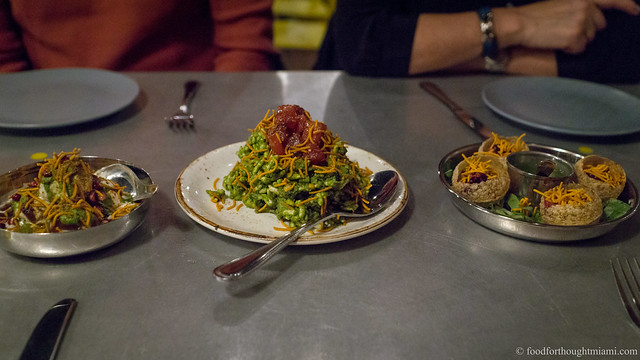 |
| dahi vada, avocado tuna bhel, pani puri - Ghee Indian Kitchen |
The combination of Indian flavors with a real-deal farm-to-table ethos – the menu highlights an increasing number of items that come straight from the Rancho Patel farm Niven and his family run in Homestead – is on display in pretty much all the dishes. But I have a particular fondness for the chaats: boldly flavored, intriguingly textured, snack-y items like the pani puri, delicate, crispy little cups filled with sprouted moong beans, diced beets into which you spoon a spiced green juice, or the dahi vada, hearty lentil fritters doused with date chutney and yogurt, or the bhel puri bound with mashed avocado and topped with raw tuna.
 |
| potato darphin, Maine uni, jalapeño - Wildair |
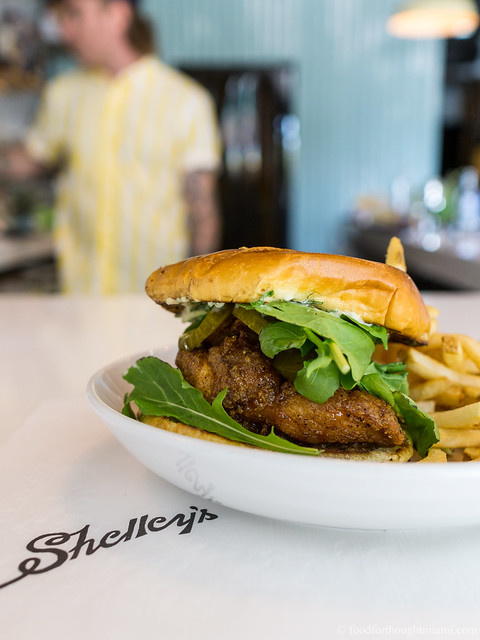 |
| fried chicken sandwich - Shelley's |
She's relaxed and friendly, but she's serious about her cooking. Like her fried chicken sandwich, one of the best I've ever had. So crispy outside, so juicy inside, layered with pickle chips and fresh greens, on a squishy bun slathered with herb-flecked mayo. But what makes it special is a hit of Vietnamese style fish sauce caramel – a pungent, funky, salty-sweet burst of umami that you don't expect and that keeps drawing you back for more.
Shelley's, I miss you.
 |
| Florida bonito, soy, Hawaiian ginger, sea salt - Gaijin by Cake |
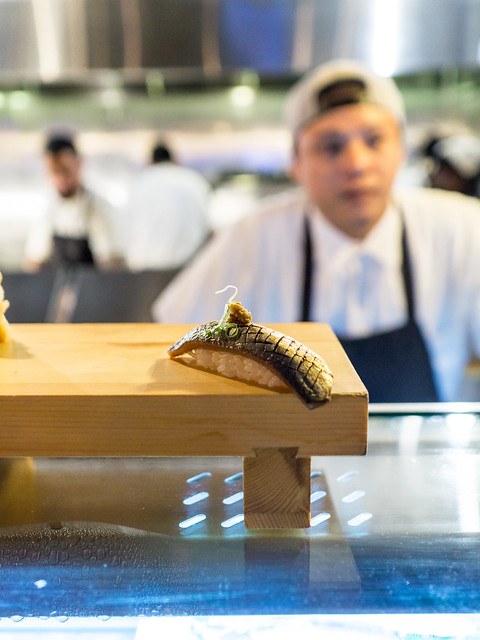 |
| Florida sardine with ginger and scallion- Gaijin by Cake |
(continued ...)
Saturday, December 8, 2018
Night at the Burger Museum
So here was a fun thing: "Night at the Burger Museum," organized and hosted by Burger Beast a/k/a Sef Gonzalez.
Most folks know Burger Beast as a passionate and voracious blogger of burgers and other comfort foods, or maybe as the organizer of record setting food truck events. Not as many may appreciate that he is also a true historian of the fast food universe, with an encyclopedic depth of knowledge about the genre and its origins. (He's got a book coming out, "All About the Burger," in a few months). Sef has also compiled quite the collection of artifacts and memorabilia, which was first kept in a warehouse in Westchester I visited a couple years ago. It now has a home at the Burger Museum in Magic City Casino, where you can find Bob’s Big Boy hobnobbing with Officer Big Mac.
Earlier this week, Sef launched something new there: Night at the Burger Museum, with the space converted into a dining room, and a menu inspired by some of the dishes that were once served at the places whose knick-knacks adorn the walls.
(You can see all my pictures in this Night at the Burger Museum flickr set).
The idea, and some of the original dish suggestions, came from Sef; the re-interpretation and execution were cooked up by Phil Bryant and Veronica Valdivia , who worked together at Norman’s 180, Yardbird and The Local before starting Heirloom Hospitality as a consulting business.
Here’s what was on the menu:
A root beer rum old fashioned, made with Havana Club Clasico rum, sassafras syrup and bitters, courtesy of the always ebullient Gio Gutierrez.
Inspired by the Burger King Yumbo Hot Ham and Cheese Sandwich: ham croquetas with a cheese center, served with "special sauce." I'll confess, I was alive for the original Yumbo (which Burger King originally offered from 1968 to 1974, then brought back for a limited time in 2014), but I have no memory of it. This recreation was a feat of engineering, a crispy globe encasing a core of minced ham and molten cheese magma.
Inspired by the Wendy's Chicken Cordon Bleu Sandwich and Sizzler's Cheese Toast: a chicken cordon bleu soup topped with crispy, spice-flecked chicken nuggets, with a faithfully recreated tranche of cheese-dusted Texas toast riding sidecar. Here's an ad with Dave Thomas hawking the original version, I'm guessing from the early 1990's.
(continued ...)
Wednesday, November 21, 2018
Cobaya Le Zoo Makoto with Chefs Julian Baker and Anthony Micari
I'm a big fan of collaborations. When you put two creative minds together, good things are bound to happen. Yet many "collaborative" dinner events turn out to not really involve all that much actual teamwork. Sure, the chefs will communicate about a menu and ingredients, and decide who is going to do what. But more often than not, they're ping-pong-ing courses back and forth, rather than working together to create dishes that are a genuine combined effort.
Which is one of the things that made our Cobaya dinner last week with chefs Julian Baker of Le Zoo, and Anthony Micari of Makoto, so special: each dish seemed to bear the imprint of both chefs, and both kitchens.
They had some advantages in doing so. The French bistro and contemporary Japanese restaurant are neighbors, both housed in the posh Bal Harbour Shops. They are also siblings of a sort, both under the management of Stephen Starr's Starr Restaurant Group.[1] And they're both Cobaya alumni, in a way: Chef Baker hosted Cobaya Experiment #40 while he was chef at Toscana Divino in Brickell, and Makoto's namesake, head chef Makoto Okuwa, was the host for Cobaya Experiment #32.
For Experiment #75, the two chefs set up a table for thirty of us right between their two restaurants: smack in the middle of the breezeway of Bal Harbour Shops over a glassed-in koi pond that runs through the center. Amidst the shoppers browsing the Dolce & Gabbana couture and Fendi purses, they served a menu that combined, in each dish, the flavors and ingredients and techniques of France and Japan. Here's a recap:
(You can see all my pictures in this Cobaya Le Zoo Makoto flickr set)
Guinea Pigs starting to make their way in for Cobaya Experiment #75.
A snack as guests arrived, and a preview of what's to come: toasted baguettes smeared with a rich, and very French, chicken liver mousse, topped with a zingy, spicy, and very Japanese, yuzu kosho marmalade.
"Toro Niçoise." Chef Micari marinated block cuts of fatty tuna sashimi in soy sauce, toro zuke, style. Chef Baker brought the flavors of the Mediterranean: pickled haricots verts, tomatoes, niçoise olives, slivered radishes, a delicate squash blossom. Someone threw in some fudgy, Szechuan-spiced egg yolk, which was a very good idea. This was a great start.
"Japanese Bouillabaisse." Chef Micari brought some seafood from Tsukiji Market in Tokyo: gorgeous head-on shrimp, silky scallops, delicate baby calamari. It arrived at the table in a bowl with a rice puff rubbed with saffron aioli, the traditional accompaniment to a Provençal bouillabaisse. The dish was then finished with a tableside pour of a rich, heady, spicy seafood stew that had been enriched with red aka miso.
(continued ...)
Which is one of the things that made our Cobaya dinner last week with chefs Julian Baker of Le Zoo, and Anthony Micari of Makoto, so special: each dish seemed to bear the imprint of both chefs, and both kitchens.
They had some advantages in doing so. The French bistro and contemporary Japanese restaurant are neighbors, both housed in the posh Bal Harbour Shops. They are also siblings of a sort, both under the management of Stephen Starr's Starr Restaurant Group.[1] And they're both Cobaya alumni, in a way: Chef Baker hosted Cobaya Experiment #40 while he was chef at Toscana Divino in Brickell, and Makoto's namesake, head chef Makoto Okuwa, was the host for Cobaya Experiment #32.
For Experiment #75, the two chefs set up a table for thirty of us right between their two restaurants: smack in the middle of the breezeway of Bal Harbour Shops over a glassed-in koi pond that runs through the center. Amidst the shoppers browsing the Dolce & Gabbana couture and Fendi purses, they served a menu that combined, in each dish, the flavors and ingredients and techniques of France and Japan. Here's a recap:
(You can see all my pictures in this Cobaya Le Zoo Makoto flickr set)
Guinea Pigs starting to make their way in for Cobaya Experiment #75.
A snack as guests arrived, and a preview of what's to come: toasted baguettes smeared with a rich, and very French, chicken liver mousse, topped with a zingy, spicy, and very Japanese, yuzu kosho marmalade.
"Toro Niçoise." Chef Micari marinated block cuts of fatty tuna sashimi in soy sauce, toro zuke, style. Chef Baker brought the flavors of the Mediterranean: pickled haricots verts, tomatoes, niçoise olives, slivered radishes, a delicate squash blossom. Someone threw in some fudgy, Szechuan-spiced egg yolk, which was a very good idea. This was a great start.
"Japanese Bouillabaisse." Chef Micari brought some seafood from Tsukiji Market in Tokyo: gorgeous head-on shrimp, silky scallops, delicate baby calamari. It arrived at the table in a bowl with a rice puff rubbed with saffron aioli, the traditional accompaniment to a Provençal bouillabaisse. The dish was then finished with a tableside pour of a rich, heady, spicy seafood stew that had been enriched with red aka miso.
(continued ...)
Monday, September 17, 2018
Cobaya Three with Norman Van Aken
Let me just get this out of the way: Norman Van Aken has always been something of an idol of mine. One of my formative food experiences was at his restaurant A Mano, which he opened in the Betsy Ross Hotel on South Beach (now known just as The Betsy) in 1991. A Mano was Van Aken's first venture in Miami after making a name for himself at Louie's Backyard in Key West, and it was a great restaurant: fancy but not stuffy, bringing classical technique and refinement to the ingredients and flavors of Latin America and the Caribbean. If that sounds old hat now, it's a testament to the influence of Van Aken and several other chefs of that generation who helped to democratize, in a way, what we think of as fine dining.[1]
I celebrated my 25th birthday at A Mano the next year, and can still recall the "Down Island French Toast" with seared foie gras and a savory citrus caramel, the massive bone-in ribeye "gaucho" steak studded with slivers of garlic and jalapeño, and a dessert that topped ice cream with bananas cooked in rum and sugar, then laced it all with a spicy-sweet chile jelly.[2] Fresh out of law school and just starting my career, in a position for the first time in my life to really celebrate the joys of good eating on my own dime, this was how I wanted to do it.
I went back to Van Aken's restaurants as often as I could – the more modestly priced Stars and Stripes Café in the front of the Betsy Ross more frequently than A Mano, and then later his longtime flagship Norman's in Coral Gables. I bought his cookbooks, and cooked from them. And I followed many of the paths they illuminated – other chefs and writers – along the way learning a good bit of what I know about food now.
So how often do you get to ask one of your idols to cook for you? We've been trying for years to make a Cobaya dinner with Norman Van Aken happen. It finally did in late July, and it was worth the wait. This was a particularly special one for me – another dinner I'll remember for a long time. Here are some notes and pictures.
(You can see all my pictures in this Cobaya Three with Norman Van Aken flickr set).
Three, in Wynwood, actually may be my favorite of the venues Van Aken has operated since he came up US-1 from Key West.[3] Part of the Wynwood Arcade, it has a dining room that glows with plush, richly hued greens and blues, a long dining counter along the open kitchen, plus a rooftop bar (No. 3 Social) which is where we started the evening.
After plying us with cocktails – a choice of the "Hit the Deck" with vodka, habanero syrup, watermelon and mint, or the "Norman's Revenge" with tequila, lime, jalapeño and a black salt rim – we were led back downstairs to the dining room, which we'd taken over for the evening.
We started with a dish inspired by a classic Mexican[4] hangover cure, "Vuelve a la Vida," a ceviche-style seafood salad with supposedly restorative powers. This one was more refined than most, combining a chilled lobster tail, a cocktail-sauce like spicy tomato dressing, a mezcal gelée (a little hair of the dog), avocado purée, and fresh cherry tomatoes, cucumbers and crunchy jicama batons. Some crispy empanadas rode along sidecar.
I loved the next dish, which put together fat, flavorful grilled asparagus spears,[5] wispy garden lettuces, a smoked benne seed dressing, and shavings of preserved citrus. It's not always easy to give depth of flavor to vegetable dishes, but this one accomplished it.[6]
(continued ...)
Subscribe to:
Posts (Atom)















